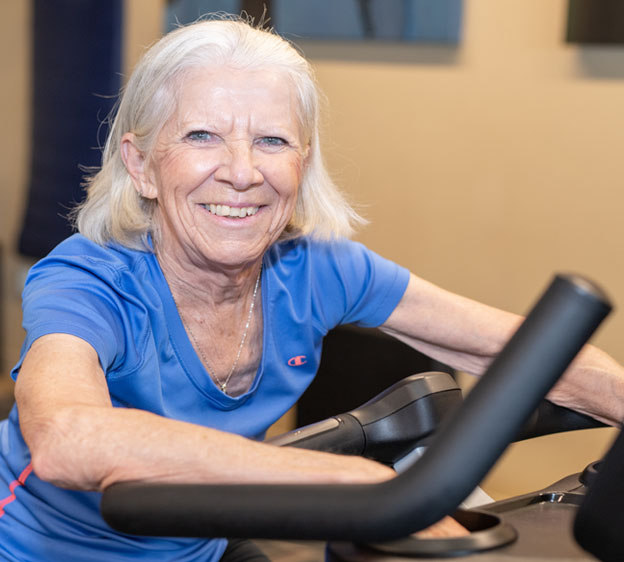Sun City Resident Enjoys Quick Recovery After Hip Replacement
September 25, 2022Categories: Hip Pain

For Chris Altieri, the sudden onset of hip pain threatened to disrupt the comfortable retirement that she and her husband Mike had long looked forward to.
Altieri, 71, is a native of Massachusetts, but when the Bay State’s cold winters began to wreak havoc with her arthritis, the couple looked for warmer climes where they could spend their retirement. That search brought them to Sun City three years ago, and they’ve been enjoying the warm, snow-free weather of sunny South Carolina since then.
“We’ve done our tour of duty with kids, work and all that,” Altieri said with her New England accent still clear. “Now it’s just time to relax and have fun.”
Today, much of their life centers around their two 2-year-old King Charles spaniels, Brandy and Shelby. After 20 years without a dog in the home, each day now starts with a long walk and maybe a game of fetch in the backyard.
But during one of these daily walks, Altieri noticed a problem.
“It started off with my hip bothering me,” Altieri explained. “I got to a point where I needed to see somebody to see what was wrong.”
A friend suggested that she see Dr. Vandit Sardana, a board-certified, fellowship-trained, orthopedic surgeon at Beaufort Memorial, who confirmed that bone-on-bone contact was causing her pain. Surgery was an option, but she didn’t feel she was ready to take that step. Instead, they developed a plan to try physical therapy before considering surgery.
“People think that going to a surgeon’s office we’re going to recommend surgery,” said Sardana. “That’s not true. I’d say that only one out of every 20 patients we see ends up having surgery. The rest are treated with other options until they get to a point that they need surgery.”
The non-surgical treatments he normally recommends include physical therapy, topical gels and injections. “I lay out all the options and let the patient decide,” he said. “Of course, I’m going to guide the process and discuss what I think is going to work or not going to work.”
Read More: Consider Your Options for Relieving Joint Pain
Altieri tried physical therapy for a few weeks, but the situation deteriorated to the point where Sardana recommended surgery and she decided it was time.
Sardana used the “Direct Anterior Approach” with Altieri’s surgery, making a small incision from the front as opposed to making a larger incision and entering from the back. The approach avoids cutting and then reattaching the key muscle group that enables patients to walk and bend.
“That’s the key to a faster recovery,” he explained. “If you cut the muscle, you suture it back together, so it needs time to heal and repair. In this case, there is no time needed to heal.”
In recent years, Beaufort Memorial orthopedic surgeons have adopted these “muscle-sparing” surgical techniques to improve hip replacement outcomes and recovery times. In addition, several surgeons have also integrated robot-assisted technology into knee and hip replacement surgery. It allows surgeons to replace joints with pinpoint precision, customizing the placement and alignment of the implant components to the patients’ unique anatomy, providing more natural movement of the joint and increasing its longevity.
And while Altieri was assured it would be a quick recovery, she was astonished by just how quick.
“They woke me up and asked me if I could walk,” she said. “They gave me a walker, and then they said, ‘Hey, can you just slow down a little?’ That was it.”
She walked out of the hospital that afternoon.
“People couldn’t believe it. I had it done on a Thursday, and I was back in the gym on Monday riding the bike,” she said. “I haven’t stopped since.”
Read More: Operating Room to Living Room in One Day or Less
Today most joint replacement patients at Beaufort Memorial spend one night in the hospital, and about a third of them, like Altieri, are able to go home the same day as their surgery.
“Her recovery was exceptional,” said Dr. Sardana. “But she was motivated, having the right mindset going into surgery and being willing to do the physical therapy work.” He indicated that most of his hip replacement patients can expect to resume some normal activities in 10 to 15 days. And by the five-week mark, he has had patients tell him they are playing golf. “All 18 holes,” he added.
And once the surgery was complete, the pain in her hip, which had become significant, was gone. She found herself moving better and, importantly, not dreading the thought of having to move.
Her husband Mike, an enthusiastic cyclist who pedals upward of 60 miles a week, decided to have his hip replaced, too. His wife’s experience influenced him to go through with the surgery.
“If you need it done, get it done,” she said. “It’s nothing to have a hip replaced anymore.”
To learn more about joint replacement at Beaufort Memorial, register for a Solving Hip and Knee Pain seminar or discuss your options with an orthopedic specialist.

